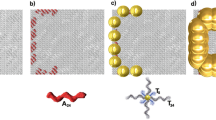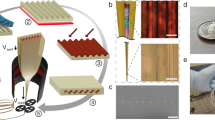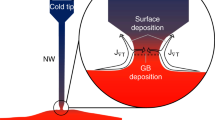Abstract
There is continued interest in finding quicker and simpler ways to fabricate nanowires, even though research groups have been investigating possibilities for the past decade. There are two reasons for this interest: first, nanowires have unusual properties—for example, they show quantum-mechanical confinement effects1, they have a very high surface-to-volume ratio, enabling them to be used as sensors2, and they have the ability to connect to individual molecules3. Second, no simple method has yet been found to fabricate nanowires over large areas in arbitrary material combinations. Here we describe an approach to the generation of well-defined nanowire network structures on almost any solid material, up to macroscopic sample sizes. We form the nanowires within cracks in a thin film. Such cracks have a number of properties that make them attractive as templates for nanowire formation: they are straight, scalable down to nanometre size, and can be aligned (by using microstructure to give crack alignment via strain). We demonstrate the production of nanowires with diameter <16 nm, both singly and as networks; we have also produced aligned patterns of nanowires, and nanowires with individual contacts.
This is a preview of subscription content, access via your institution
Access options
Subscribe to this journal
Receive 12 print issues and online access
$259.00 per year
only $21.58 per issue
Buy this article
- Purchase on Springer Link
- Instant access to full article PDF
Prices may be subject to local taxes which are calculated during checkout




Similar content being viewed by others
References
Krans, J.M., van Ruitenbeek, J.M., Fisun, V.V., Yanson, I.K. & de Jongh, L.J. The signature of conductance quantization in metallic point contacts. Nature 375, 767–769 (1995).
Cui, Y., Wei, Q., Park, H. & Lieber, C.M. Nanowire nanosensors for highly sensitive and selective detection of biological and chemical species. Science 293, 1289–1292 (2001).
Reed, M.A., Zhou, C., Muller, C.J., Burgin, T.P. & Tour, J.M. Conductance of a molecular junction. Science 278, 252–254 (1997).
Adelung, R. et al. Self-assembled nanowire networks by deposition of copper onto layered-crystal surfaces. Adv. Mater. 14, 1056–1061 (2002).
Adelung, R. et al. Tuning dimensionality by nanowire adsorption on layered materials. Phys. Rev. Lett. 68, 1303–1306 (2001).
Adelung, R., Brandt, J., Kipp, L. & Skibowski, M. Reconfiguration of charge density waves by surface nanostructures. Phys. Rev. B 63, 165327 (2001).
Salomon, A. et al. Comparison of electronic transport measurements on organic molecules. Adv. Mater. 15, 1881–1890 (2003).
Carrette, L., Friedrich, K.A. & Stimming, U. Fuel cells — fundamentals and applications. Fuel Cells 1, 5–39 (2001).
O'Hayre, R., Lee, S.J., Cha, S.W. & Prinz, F.B. A sharp peak in the performance of sputtered platinum fuel cells at ultra-low platinum loading. J. Power Sources 109, 483–493 (2002).
Thran, A., Kiene, M., Zaporojtchenko, V. & Faupel, F. Condensation coefficients of silver on polymers. Phys. Rev. Lett. 82, 1903–1906 (1999).
Rayleigh, Lord On the stability of a cylinder of viscous fluid under a capillary force. Phil. Mag. 34, 145–154 (1892).
Sordan, R., Burghard, M. & Kern, K. Removable template route to metallic nanowires and nanogaps. Appl. Phys. Lett. 79, 2073–2075 (2001).
Zaporojtchenko, V., Zekonyte, J., Biswas, A. & Faupel, F. Controlled growth of nano-size metal clusters on polymers by using VPD method. Surf. Sci. 532–535, 300–305 (2003).
Biswas, A. et al. Controlled generation of Ni nanoparticles in the capping layers of Teflon-AF by vapor phase tandem evaporation. Nano Lett. 3(1), 69–73 (2003).
Acknowledgements
We thank J. Kruse for help with the gold deposition. This work was supported in part by the DFGF-orschergruppe 353/2-1 and the Technologiestiftung Schleswig-Holstein, project 2002-11.
Author information
Authors and Affiliations
Corresponding author
Ethics declarations
Competing interests
The authors declare no competing financial interests.
Rights and permissions
About this article
Cite this article
Adelung, R., Aktas, O., Franc, J. et al. Strain-controlled growth of nanowires within thin-film cracks. Nature Mater 3, 375–379 (2004). https://doi.org/10.1038/nmat1128
Received:
Accepted:
Published:
Issue Date:
DOI: https://doi.org/10.1038/nmat1128
This article is cited by
-
Nature-inspired micropatterns
Nature Reviews Methods Primers (2023)
-
Parallel Nanoimprint Forming of One-Dimensional Chiral Semiconductor for Strain-Engineered Optical Properties
Nano-Micro Letters (2020)
-
Universality of periodicity as revealed from interlayer-mediated cracks
Scientific Reports (2017)
-
Ultra-sensitive Pressure sensor based on guided straight mechanical cracks
Scientific Reports (2017)
-
Anomalous Epitaxial Growth in Thermally Sprayed YSZ and LZ Splats
Journal of Thermal Spray Technology (2017)



